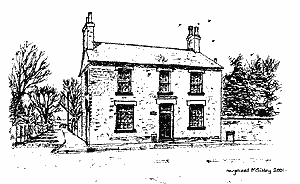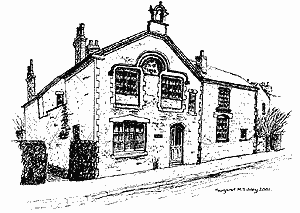![]()
Moor Lane, Newgate Street, Kirkhill, Fairfield Street and School Lane
Moor Lane
led to the Moor Close and later to the gasworks across the railway line to the north. Note the remains of the painted sign of the former Tip Top bakery at first-floor level of the chequered building on the corner of Market Place. Moorlands old people's home, demolished in 2001 and replaced in 2002 by a development of apartments, was itself on the site of the former Beauvale House farmyard that was still functioning in 1950. Chapel Yard was on the corner of Newgate Street and held several poor houses and Mr Downing's slaughterhouse. Bingham’s first parish workhouse was built in 1769 in Moor Lane as well as the small lockup.
![]()
Newgate Street
was once Back Lane. Nº 8 is a late 18th century Georgian farmhouse originally owned by the Chesterfield Estate and sold only in 1952. The farmer moved to a newer farm, still called Newgate Farm, on Nottingham Road to be closer to his fields. The gable end of its adjacent former barn bears the date 1817. Note the hinge supports carved from a single piece of stone. There is a matching door to the rear allowing access from the farmyard as well as the street. The floor between the doors is of York stone flags. Its original stables are in the front garden of No10. Gillotts Close, more infill named for former tenants of the farm, is on land that belonged to the farm. James Walker built the late Victorian villas (Nºs12&14). Nº16a was the last remaining stocking frame house in Bingham, but the wide upstairs windows were removed in the 1980s. The lower brickwork of the front half of Number 20 is early 1700s. The barn has a dated brick (1862) within the vitrified brick diaper pattern in the gable which supports the dating of the iron hinges to the mid nineteenth century. The trade directories record a succession of cottagers in Newgate Street who could well have lived here, the plot is about the right size for such an occupation.
James Terrace of semi-detached villas (Nºs22-32) were built in 1904/5 on the north side on land leased by the Earl of Carnarvon to James Walker. Frederick Castledine bought all six when he retired from his grocery business, and the Earl sold him the freeholds in 1920. On the South side Nºs9 and 11 were built on green field plots leased from the Earl of Carnarvon. He sold the freeholds in 1920. A tailor built Nº9 about 1897 as a residence with a projecting shop front that did not disappear until the 1960s. It was a drapers and wool shop from the 1930s. The single storey lean-to may have been the tailor's workshop; it served as a basket-weaving classroom in the 1920s. Later it was Bingham's public library until 1974. You can see the patches in the brickwork where the shop door and window were. Close Acre is a classic example a house facing south, with small windows on the north side; in 1920 it had a rear door onto the street. It and Rose Cottage are mid 19C.
![]()
Kirkhill
is named for the Chapel of St Helen built by Richard de Bingham in 1301 at the western end of School Lane, which used to be Mill Lane. A windmill occupied the site of Nºs1&3. Old maps show the mill as derelict in 1901. The miller (Thomas Walker in 1832) owned three closes (Mill, Kirkhill and Chapel) amounting to 10 acres. The 1841 Tithe map shows a second mill about where Carnarvon Place is now, on what was known as Mill Close. We think this was operated by Robert Wilson who the 1841 & 1851 censuses show as living in Fair Close. See the plan at 15 Fairfield Street. The new Board School was built in 1909, opening in 1910. On part of Kirkhill Close. Joseph Baldock, Relieving Officer for the Workhouse, built No9 School Lane on another part of Kirkhill Close in 1920.
 Kirkland House |
Kirkland House stands on Chapel Close. Human remains have been found in the grounds suggesting it is the site of the chapel cemetery. In 'Bingham in the Past’ it is reported that the 46 victims of a plague in 1646/7 were buried in a yard at the west end of the town. The house was built in about 1860 and extended a few years later to incorporate a bakehouse at which time the corner room was converted to a shop with the door across the corner. The faint remains of a painted advertisement can still be seen above where the shop window was. A photograph of the shop front is in Victorian Bingham, ed Val Henstock. Foreshadowing today's developers, James Walker purchased Kirkland House (No1) and its land in 1908. He sold the house to the Board of Guardians of the Workhouse, which was already renting it for a cottage children's home. By 1910 he had built seven villas, including 'Westholme' (No11) on the land. |
| Kirkhill's other association with Bingham's children is the Wesleyan School at the bottom of the hill. Note the school bell turret. (This had to be removed for safety reasons in 2002 but it is hoped might be reinstated) Designed by R C Sutton in the Italianate style and built in 1850, the complex of buildings here also housed the circuit superintendent and ministers of the Wesleyan church. They moved to the Banks in the 1880s. The school became the Board School in 1871. It closed when the new school opened in School Lane. The schoolmaster, Harry Pilling, became head of the new school and bought 'Westholme'.
Wesleyan Day School |
 |
![]()
Fairfield Street
was Pond Street for about 10 years around 1881 - the pond was near 'Edmunderry' (No2). It reverted to Fairfield Street after the pond was filled in and commemorates an annual fair held on Fair Close, on the corner with Newgate Street. The original name of the street, was Fair Close. The large plot of allotments bounded by Fairfield Street, west Newgate Street and by properties on Long Acre and Market Place was sold by the Earl of Carnarvon in 1920. The houses on this side of Fairfield Street date from the 1920's onwards.
Yorkshire sliding sash windows suggest the former cottage attached to the White Lion is late 18C or early 19C, and the pub itself is of similar age but was refronted later. The Stingo Tap, one of Bingham's many drinking houses listed in the 1844 directory, preceded it, probably in the original cottage building.
The west side of Fairfield Street has a range of interesting buildings from the mid and late 19th century. Intriguingly Nos 9,11,15,17 all have cart entrances. Numbers 11 and 15 were built in 1822 but number 15 was rebuilt in 1888. In the 1920s fishmonger Tommy Cod lived at No15, and directories through the 1800s record other residents of Fairfield Street who may have needed carts, including pig jobber, butter huckster (OED: hawker or pedlar) and carrier, builder and several cottagers who would have needed the long back gardens attached to these houses. The true period of the Anchorage is masked by modern timber decoration.

West Side, Fairfield Street
